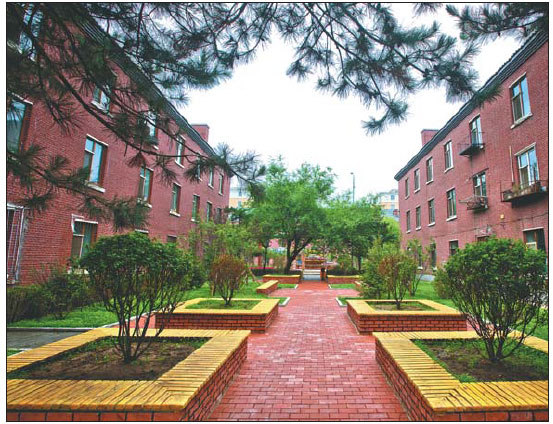Old area reborn following spruce up work
The reconstruction project of Changchun's old city has influenced and changed the lives of more than 2 million residents in the downtown area, in the process winning glowing praise from locals.
Changchun's government wanted to solve the problem of the poor infrastructure and housing environment, to boost the wellbeing and contentment of residents. To do so it followed a concept of being people-oriented.
Shanghai Road, an old street built in the 1920s and located in Changchun's downtown Nanguan district, was listed as a key reconstruction block.
Plans were made to take Changchun's traditional brick-red architecture as a foundation and create featured architecture in the nostalgic as well as the modern style.
Locals are happy with the outcome.
"In the past, the street was filthy: bricks were very damaged, the stairs were incomplete and telegraph poles were tilting," said Li Moru, who has lived in the area for more than 50 years.
"It was very dangerous to walk on the street and inconvenient to buy things there. But now, the reconstruction has brought more convenience to our lives."
Yang Xue, an officer of Changchun Nanguan District Urban and Rural Construction Committee detailed some of the work.
"We renovated some old shop signboards and resprayed the building surfaces to refresh its original historical appearance," Yang said.
In the Youdian residential area, located at the intersection of Changqing Street and Jinyihe Road, in Chaoyang district, a facelift of apartment buildings replaced previous illegal structures.
Yu Heping, an official of Chaoyang District Old City Reconstruction Office, said that they paid significant attention to improving infrastructure - such as water, power, heat and gas supplies - which is closely linked to people's daily lives.
Local authorities have listened to the opinions of residents, mending stairs, whitewashing corridors. They have established an effective long-term management system and added support facilities to the area, which include an installed video surveillance system.
The government also brought a cultural concept to the reconstruction of Youdian residential area, combining socialist core values to build a themed area.
Illegal constructions were always a problem in Changchun old city, which led to the dirty environment and potential risks, according to the government.
Places like Anyang Street in Lyuyuan district, also called Disappeared Street by locals, were filled with many stalls and steel shelters and attracted complaints for years.
To solve the problem, the government demolished 17,836 illegal buildings, 1.36 million square meters in total.
In addition to the reconstruction of its appearance, the government also attached great importance to problems lurking underground, such as faulty and broken drain-pipes that were seriously blocked - and causing a sewage runoff.
Locals complained about trenches that were filled with excrement and about corroded water pipelines. A resident said that they used to raise money in the community to repair the pipes, but it proved useless.
The underground pipeline system was complex, with intermixed natural gas lines and optical cables. It was also built many years ago, so related information and drawings were incomplete.
To solve the problem, the government reconstructed the underground pipes of 11 old apartments, with all the pipes stretching 40 kilometers in total.
"A few months ago, the street was impassable and dust was everywhere when the workers were reconstructing our buildings. I thought it is a sheer waste of people and money," said a resident, surnamed Zhou, from Sipinglu community.
"When it was completed we were surprised by the new look. Our building was rebuilt, the cables were channeled systematically in the ground and corridors were painted white, which made the local residents very satisfied."
|
Changchun's government wants to solve the problem of poor infrastructure and a housing environment, to boost the well-being and contentment of residents.Provided To China Daily |
(China Daily 09/13/2017 page14)















